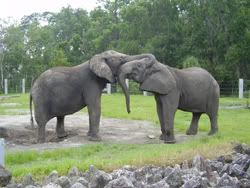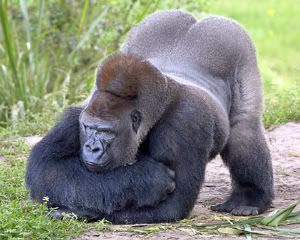ATTRACTION :Jacksonville Zoo & Gardens.
WHERE: 370 Zoo Parkway, Jacksonville, FL 32218.
AGE RESTRICTIONS: None.
PRICE: $13 for adults aged 13 and up, $11 for seniors aged 65 plus. $8 children ages 3—12. Under 3 year olds are admitted free. Prices are plus tax.
ADDITIONAL INFORMATION: Open 9am until 5pm seven days a week. From March 1st until September 1st, the zoo will stay open an extra hour on a weekend. Phone(904) 757-4463 [email protected]
Proper attire, including shirt and shoes, must be worn at all times.
There is no smoking allowed on the zoo grounds, picnic area or in the parking lots.
Roller skates, roller blades, skateboards and bicycles are not allowed inside the zoo. Personal music players must not be amplified.
No coolers or picnic food is allowed inside the park. Picnic grounds are located at the south end of our parking lot, near Education Campus. You are allowed to bring your own food and beverage into this area, as they do not allow outside food and drinks into the zoo.
For your enjoyment, the Zoo features two full-sized restaurants, a snack bar and an ice cream pavilion. Located throughout the zoo, you are never more than a few steps away from refreshment.
RENTALS:
Navigate the 89-acre park in comfort! Scooterbug wheelchairs and strollers are available for rent for your convenience.
Single Stroller: $6 + tax
Double Stroller: $8 + tax
Manual Wheelchair: $6 + tax
Electric Wheelchair: $18 + tax
The rental booth is located inside the main gates across from the train station.
All units are first come, first served and a valid driver’s license is required to hold until the unit is returned.
The zoo has something for everyone with over 1,500 rare and exotic animals and 1,000 varieties of plants.
River Valley Aviary: Home to exotic birds representing many different species, the River Valley Aviary is a two-story enclosure covering 9,000 square feet. It allows birds such as the yellow-billed stork, white-bellied bustard, lesser flamingos and turacos to fly about freely.
African Loop: Guests can walk along the 1,400-foot long boardwalk and see the animals in their large, open environment called the Plains of East Africa.
The Nile crocodile exhibit is the first exhibit you’ll see. The crocodile is the largest of African reptiles and can grow 14-16 feet long. Mainly found in sub-Sahara Africa, these crocodiles are notorious for preying on large mammals.
The Wart Hog exhibit is across from the Nile crocodiles.
The Antelope exhibit is in the centre of the loop around the Plains. Home to eastern bongo, impala and African ground hornbills, the exhibit is spacious and tree-shaded. It is also home to a wild breeding colony of the endangered wood storks.
A pair of Saddle-billed Storks is in the area across from the antelope exhibit. This rare stork species is the tallest of the African storks. Wattled crane, the rarest of the African cranes, also occupy this area.
The Cheetah exhibit is a 300-foot long, 50-foot wide area. Cheetahs are capable of running 70 miles per hour, the fastest four-legged animal in the world.
White rhinoceros, greater kudu, sitatunga and ostrich inhabit three exhibit areas that encompass a 2.5-acre area, allowing plenty of room for the animals to roam.
Rare Cape Buffalo are further along the boardwalk and are one of the most dangerous animals in Africa.

 Elephant Plaza offers an intimate view of the elephants and their 275,000-gallon pool. Included in the same area is the Seronera Reptile Building, home of some of the world’s deadliest snakes, such as vipers, cobras and mambas. In the Plaza, there are vultures, bats, klipspringers and other animals.
Elephant Plaza offers an intimate view of the elephants and their 275,000-gallon pool. Included in the same area is the Seronera Reptile Building, home of some of the world’s deadliest snakes, such as vipers, cobras and mambas. In the Plaza, there are vultures, bats, klipspringers and other animals.
Mahali Pa Simiba (“Place of the Lion” in Swahili) is the one-acre home to the lions.
Angola colobus monkeys live in the area in front of the lions’ area. These monkeys move by leaping from tree to tree which makes for a very lively exhibit.
Leopards are at the end of the African Loop and can be viewed from the gazebo or along the main path.
Giraffe Overlook: Take a stroll across the elevated viewing platform and get eye-to-eye with a giraffe. The covered boardwalk gives guests a breathtaking view across a replica of the African Savannah. Giraffe and greater kudu walk and graze freely in this 2.5 acre exhibit adjacent to the Savannah Blooms botanical gardens.
Range of the Jaguar: At the edge of the rainforest, which holds the animal exhibits, is a village area including the Palm Plaza restaurant, gift shop and restrooms. In addition to enjoying the breathtaking jaguar exhibits, take the time to walk the winding halls of the captivating Lost Temple to see bushmaster snakes, poison dart frogs, vampire bats, Amazon tree boa constrictors, anaconda, cotton-topped tamarins, pygmy marmosets and more.
Catch sight of howler monkeys, giant anteaters, capybaras and tapirs coexisting in the River’s Edge exhibit.
As an Inca tern flies overhead in the Emerald Forest Aviary, a pudu, the smallest deer species, might dart across your path. Look for a red-capped cardinal perched above you or a sunbittern sunning itself on a low branch. While in the aviary, you’ll have an opportunity to see the largest freshwater fish, the arapaima, which can grow up to 15 feet in length and can weigh up to 400 pounds.
Rare Giant Otters will entertain you with their playful antics at the back of the Aviary.
Australian Adventure: Take a walkabout through the Australian Adventure exhibit. Animals in this South Pacific attraction include the wallabies, the cassowary, and lorikeets that you can feed in a free-flight aviary.

Great Apes: Visitors can get an up-close look at all three kinds of primates in the Great Apes exhibit. The three primate groups are the apes, monkeys and prosimians. The ape primate group consists of the western lowland gorilla, bonobo, siamangs and colobus monkeys. The mandrills represent the monkey primate group and the prosimians include the ring-tailed and black and white-ruffed lemurs.
Wild Florida: Wild Florida is 2.5 acres of natural wetlands consisting of native animals and plants and is home to black bears, otters, red wolves, whooping cranes, bald eagles, bobcats, alligators, Florida panthers, white-tail deer, an owl species and various reptiles and amphibians.
The Reptile House at Wild Florida is home to more than 25 different species of reptiles and amphibians including the eastern indigo snake, one of several threatened species protected by the State of Florida. The alligators are presently located just north of the reptile house, and are fed every Saturday at 2:15 p.m. from mid-April through November.
Behind the Scenes Tours:
One of the expert zookeepers will take you behind-the-scenes for a personal walking tour of some of your favourite zoo animals and their habitats. Get closer to the animals than you would from public access, visit their night dens, learn about their care and feeding, animal habits and more.
Current tours feature animals in the African Plains, including elephants, rhinos, giraffes, zebras, warthogs, cheetah and Cape buffalo. Finish off the tour with a close-up encounter with the jaguars.
Group Size: Minimum of 6, maximum of 15, per guide.
Minimum Age: 6
Cost: $25 per person, includes park admission
Tours are scheduled from 12:00 p.m. to 4:00 p.m.
Walking shoes required, uneven pavement. No strollers or infants.
Two week advance reservations are required. Call (904) 757-4463, ext. 103 to schedule your tour. Pre-payment is required.

No comments yet.